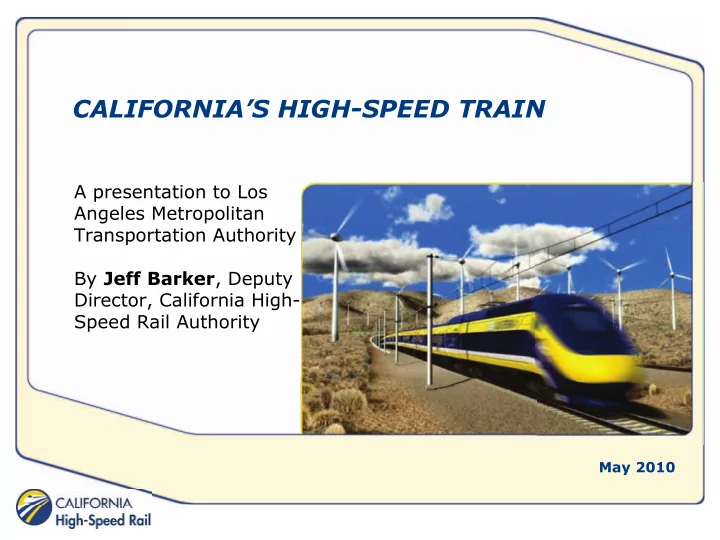

CALIFORNIA’S HIGH-SPEED TRAIN A presentation to Los Angeles Metropolitan Transportation Authority By Jeff Barker , Deputy Director, California High- Speed Rail Authority May 2010
BACKGROUND • First discussions started 30 years ago • Proposition 1A • Environmental review • Studies reflect input from the people
CALIFORNIA’S HIGH-SPEED TRAIN SYSTEM Largest public infrastructure project in U.S. history • 800-mile system (520 miles in phase one) • Operating speeds: 110-125 mph in urban areas; 220 mph in rural areas • 100% clean electric power • Safely grade-separated • Reliable, easy way to travel • Environmentally responsible • Creates jobs/ stimulates economy
PHASE 1 • San Francisco-San Jose • San Jose-Merced • Merced-Fresno • Fresno-Bakersfield • Bakersfield-Palmdale • Palmdale-Los Angeles • Los Angeles-Anaheim
SUBSEQUENT SECTIONS AND ALTAMONT CORRIDOR • Los Angeles-San Diego (via Inland Empire) • Merced-Sacramento • Altamont Corridor Rail Project
WHY WE NEED IT Jobs • 600,000 full-time, one-year, construction-related job-equivalents • 5,000 permanent operations and maintenance jobs • 450,000 economy-wide jobs by 2035 Mobility • “Economic power is how fast you move people and goods around the state.” Gov. Arnold Schwarzenegger, January 15, 2008. Environment • Reduced air pollution • AB 32: California’s 2006 landmark legislation to reduce greenhouse gas emissions 25% by 2020
WHY WE NEED IT Sustainable Communities: “Smart Growth” Vision California: • How can land use and transportation investments help solve California’s environmental and fiscal challenges? Transit-oriented development: • Minimize urban sprawl and impacts to open space • Enhance connectivity with local transportation systems
WHY WE NEED IT Status quo is not an option Population Growth • California’s population now: 38 million By 2035: 50 million We can build… • New freeways, airport runways and more departure gates to address our expected population growth or • 800-mile high-speed train system, powered by 100% renewable electricity generated by clean wind and solar energy
MOMENTUM In 2008 Californians passed Proposition 1A • $9.95 bond measure – first state to pass funding in the nation The Federal Government supports helping fund the system through the American Recovery & Reinvestment Act • $2.25B grant awarded in January 2010 • Largest award for high-speed train funding received by any state Private sector interest • Seeking $10-12B through public-private partnerships (P3) • Request for Expressions of Interest issued spring 2008 • Next: solicit preliminary comments on planned RFQ process in late 2010 International interest • MOUs to share expertise with China, France, Germany, Italy, Japan, Korea and Spain
WHERE WE ARE NOW Transitioning from Planning to Implementation Project-level EIR/EIS in process for all nine sections � All sections have completed scoping and completed the analysis of alternative alignments or have it underway � Receiving public input on alternative alignments � September 2011-October 2012: Target dates for state and federal certification of all seven Phase 1 sections � On track to meet requirements for ARRA funding
FUNDING Projected overall construction cost: $42.6 billion (Anticipated funding sources) • California Funding: $9B • Federal Funding: $17-19B • Local Funding: $4-5B • Private Investment: $10-12B
WHERE WE ARE NOW Transitioning from Planning to Implementation Federal Funding: A Key Component for Success • Completed – American Recovery and Reinvestment Act ( ARRA ) grant of $2.25B awarded in January 2010 • In Process – Three applications for Passenger Rail Investment and Improvement Act (PRIIA) grants submitted in mid-May, could provide as much as $16.6M • Coming Up – Innovative finance and loan programs that the Authority or a private investment concessionaire could use to reduce borrowing costs
RECOVERY ACT FUNDING: WHERE? ARRA projects: • Los Angeles-Anaheim • Fresno-Bakersfield • Merced-Fresno • San Francisco-San Jose
RECOVERY ACT FUNDING: LOS ANGELES-ANAHEIM Los Angeles to Anaheim section – � 92,000 construction-related jobs generated over the course of construction � High-speed train facilities at Los Angeles Union Station, Norwalk Station and the Anaheim Regional Transportation Intermodal Center � Grade separations, utility relocation, guideway structures, tunneling, earthwork and track � Environmental mitigation and right-of-way acquisition
WHERE WE ARE NOW Transitioning from Planning to Implementation Developing collaborative planning agreements with regional governments
NEXT STEPS • 2012 EIR/EIS process complete – in all Phase 1 (Anaheim- Los Angeles-San Francisco) sections, construction start-up • 2015 Begin testing the first – prototype trainsets • 2018-20 Launch operations on – Anaheim-Los Angeles- San Francisco
LOOKING AHEAD Contact Info California High-Speed Rail Authority – 925 L St., Suite 1425 – Sacramento, CA 95814 916-324-1541 – www.cahighspeedrail.ca.gov –
Recommend
More recommend